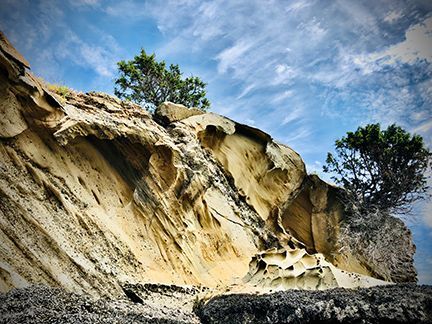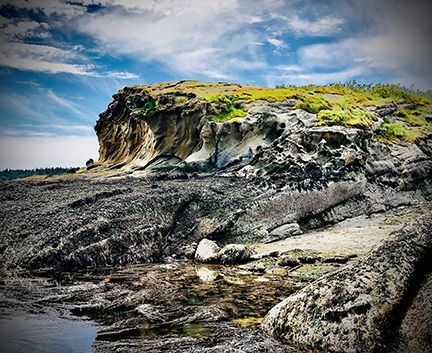SANDSTONE
The Pacific Northwest region of North America is known for its stunning and diverse geological features. Among these, sandstone stands out as one of the most interesting and distinctive types of rock formations in the area. Although it looks like it could be the surface of the moon, it is very much of this earth, made from many different rock and sand particles that exist on their own.
A tour we think you'll love

Formation and Age of Pacific Northwest Sandstone
Sandstone is a sedimentary rock formed by the accumulation and cementation of sand particles. It is typically composed of quartz, feldspar, and other mineral grains, held together by a natural cementing material, such as silica, calcium carbonate, or iron oxide. Sandstone can take on a wide variety of colors and textures, depending on the composition of its minerals and the conditions under which it formed.
The sandstone found along the Pacific Northwest coast is primarily of the Eocene epoch, which lasted from 56 to 33.9 million years ago. During this time, the region was covered by a warm, shallow sea that was rich in marine life. The sediments that accumulated on the sea floor over millions of years eventually solidified into sandstone as they were buried and compressed by layers of other sediment.

One of the most distinctive features of Pacific Northwest sandstone is the presence of fossils. The region’s sandstone is known to contain a wide variety of marine fossils, including shells, snails, clams, and even whale bones. These fossils provide important clues about the area’s geologic history and the evolution of marine life over millions of years.

Role of Sandstone in the Geography of the Pacific Northwest
Sandstone plays an important role in shaping the geography of the Pacific Northwest coast. The erosion-resistant nature of sandstone means that it tends to form cliffs and other prominent landforms that stand out against the surrounding landscape. Some of the most well-known examples of Pacific Northwest sandstone formations include the sea stacks and rock formations at Cannon Beach, Oregon, and Shi Shi Beach, Washington.
Sandstone also plays a critical role in the hydrology of the Pacific Northwest region. Because sandstone is porous, it can store and transmit water through its pores and fractures. This makes it an important source of groundwater for the region’s ecosystems and communities.
In addition to its hydrological significance, sandstone also has cultural and historical significance in the Pacific Northwest. Many indigenous peoples of the region have long relied on sandstone for tools, weapons, and other utilitarian objects. The region’s sandstone formations have also been the subject of numerous works of art, literature, and photography, showcasing their aesthetic appeal and symbolic importance.

As mentioned earlier, sandstone formations are a prominent feature of our San Juan Islands. Two notable formations are on Sucia Island, a Washington State Marine Park, and the rock outcroppings at Lime Kiln Point State Park, on San Juan Island, which are believed to be remnants of an ancient seafloor. In general this region has some of the most notable examples of sandstone formations.
On our sailing tours we often go to shore at low to mid tides in our electric-powered dinghy, or guests kayak or paddle board along the shore to view the cliffs, caves and protruding “statues” up close.









